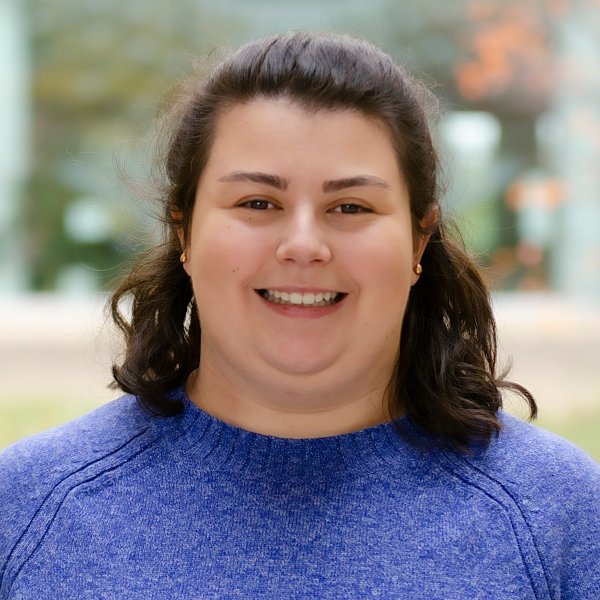
Some of our 2021 Senior Biochemistry Majors and their Research

Emmanuella Dwomo Agyei - Advisor: Dr. Nadia Marano
The Depolymerization of Isolated Amyloid Protein from Haloferax volcanii
The extracellular matrix of archaea is mainly made up of polysaccharides, extracellular DNA, and amyloid proteins. Amyloid proteins are formed from soluble proteins which aggregate into insoluble fibers. The amyloid fibers serve as protein scaffold, aids in adhesion to surfaces, and make the organism resistant to environmental stresses. Microorganisms assemble functional amyloids under controlled pathways. The assembly of amyloid fibers is thermodynamically favorable since the amyloid proteins can seed or cause their own oligomerization. This favorability makes it challenging to produce stable amyloid monomers when proteins that promote their polymerization are present. A previous study by Heather Raimer ‘17 reported the repolymerization of amyloid monomers when resuspended in water. This research aims to find a method of depolymerizing the amyloid fibers of Haloferax volcanii into stable monomers and also study the ability of the monomers to repolymerize back into its polymeric state. Ultimately, this will allow us to be able to study the structure and composition using sequencing and atomic force microscopy respectively. The amyloid fibers from Haloferax volcanii will be isolated and purified using sonication, differential centrifugation, and tube gel electrophoresis. The amyloid fibers will be depolymerized with formic acid and resuspended in water or urea which maintains proteins in an unfolded state. SDS-PAGE and ThT assay will be used to confirm the depolymerization. The effect of other variables such as the solution the monomers are resuspended in and concentration of the monomers could be studied to determine their impact on the repolymerization of the amyloid monomers.

Allison Krauss – Advisor: Mr. Stacy Vassar
Bringing Technology Into the Organic Chemistry Lab: QR codes and Step-by-Step Instructional Videos
Due to the current challenges of the world, learning through videos is a crucial part of class preparation. Educational videos offer students the opportunity to learn in a safe environment. They are unique in their ability to allow students to see something first hand, but are accessible from anywhere. The goal of this project is to create a series of organic chemistry lab tutorials. These videos will allow students to view the content from home and come into lab with a better understanding of what they are meant to be doing. Research on chemistry pedagogy and video production, allowed for the compilation of a list of steps aimed to streamline the production of organic chemistry lab instructional videos. A series of videos covering the topics of melting point, recrystallization, and drying agents were produced. Videos were previewed by current organic chemistry students to ensure quality. The feedback was positive and showed improved understanding and visualization, thus making this process a success. This project will continue further with the production of videos on different procedures, uploading of videos onto YouTube, and implementation of QR codes which will enable students to scan a barcode and be directly connected with the video of interest.

Hayley Snodgrass – Advisor Dr. Emily Dixon
A study of the function of the yeast gene SEF1
In my project, I am using bioinformatics, growth assays, and RNA sequencing to learn about the function of SEF1, a transcription factor of unknown function in the baker’s yeast Saccharomyces cerevisiae. This transcription factor is hypothesized to exist inside of the nucleus of eukaryotic organisms, but the function has not been confirmed. Its name stands for suppressor of essential function, but the essential function is still unknown. I used bioinformatics to discover the basics of SEF1. While there was little known, I was able to gather clues about its function. A growth assay was used to determine growth differences in wild type Saccharomyces cerevisiae and a mutant containing the sef1 deletion strain in three different treatments: a 30°C control, 37°C-25°C cold shock treatment, and a 1M sorbitol treatment. This growth experiment was used to show a difference in growth between the wild type and the mutant strain missing SEF1 in the various conditions. The DNA of the large and small colonies of the mutant strand were isolated and sent for sequencing to determine which colony is the mutant. After the mutant is known and a significant treatment is established, the RNA will be sequenced from the mutant strain and studied in comparison to transcription factors with a similar makeup.

Beinan Yang – Advisor: Dr. Samuel Tartakoff
Design and Synthesis of Proflavine-Derived DNA Intercalators
Intercalation is the process by which ligands insert between two base pairs thus causing the local unwinding of double stranded DNA. This process is commonly used to analyze DNA molecules and it is the basis of chemotherapeutic treatment that using DNA intercalators. As one of the intensively studied DNA intercalators, proflavine can cause the base-pair deletions or insertions, thus inhibiting the DNA replication. This project focuses on synthesizing the condensation product of proflavine and Itaconic acid. The compound obtained will be purified by hot filtration and recrystallization. IR, H1 and C13 NMR will be used to characterize the product. The kinetics and DNA intercalation of synthesized compound will be analyzed using models developed by Dr. Glazier Research group. Future experiments will focus on further functionalizing the derivative molecule and studying the kinetics data for better understanding of the mechanism of DNA intercalation.
